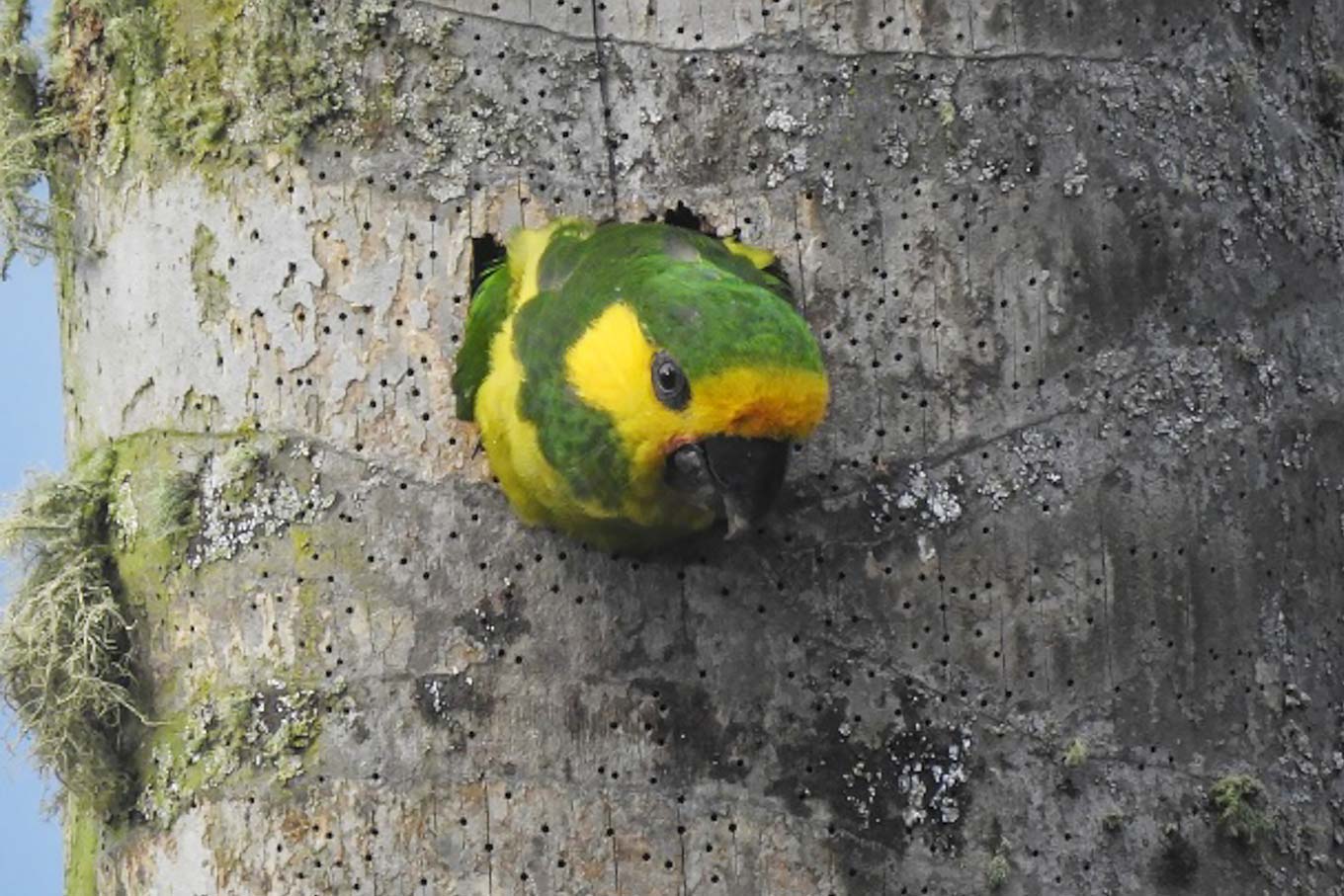In 1999, shortly after the rediscovery of Yellow-eared Parrot in the Central Andes of Colombia, the Loro Parque Fundación (LPF) commenced its support of the conservation endeavour to prevent its extinction and bring about its recovery. The LPF support continues unbroken to this day, currently assisting the work of Fundación Vida Silvestre (Wildlife Foundation), a Colombian NGO, and during these 25 years the success of the actions taken has resulted in the level of threat to the species being downgraded from Critically Endangered to Vulnerable. Not only has the population increased very substantially, to more than 2,600 from the original 81 individuals in 1999, but also the geographical distribution continues to expand.
Yellow-eared Parrot is a bird of the mountains, reported to inhabit the zone from 1,200-3,400 m within which it favours areas dominated by wax palms in which it roosts, nests and feeds. Wax palms are native to the mountain forests of the Andes but as these forests have been progressively cleared for agriculture, wax palms have been left in open areas isolated from the forest, but still used by Yellow-eared Parrots. The gradual expansion of the range of this parrot is largely related to where wax palms are found and has primarily occurred in the Central Andes. However, there are some records from the East Andes, and the most recent reports are from 2022 and 2023 in the Department of Boyacá (Peña-Ramírez et al, 2023). The site of the reports is the most north-easterly that has yet been recorded for Yellow-eared Parrot in the current expansion phase of its distribution.

Yellow-eared Parrot relies heavily on wax palms for feeding, nesting and roosting (FVS).
This new record in Boyacá was first made in April 2022 at 2,325 m elevation in a landscape of open and pastured areas that surround a protected area, the Cuchilla de Sucuncuca Protective Forest Reserve. A group of 31 individuals was observed foraging in a milky fig tree, and then in June a group of 53 were also feeding on milky figs. In August a group of 10 individuals was observed. All the records were made in the same area, with a distance of approximately 60 km between the reports of June and August. Finally, in March 2023, two pairs of Yellow-eared Parrots were found apparently nesting in a dry trunk of a palm tree. The adults were bringing food to the nests, which therefore likely contained nestlings, but on another visit later that month the species was not found.
It is well known that this parrot is nomadic and makes extensive altitudinal movements, which is possibly linked to spatial and temporal variation in food availability and its fluctuation in different areas. The new records indicate that the species is present in the area of sightings between March and August, which coincides with the time when it is absent in San Juanito (Department of Meta), approximately 90 km to the south-west. It may be a population with seasonal movements between the two areas.
On the other hand, another 80 km further south near Cubarral is a population that appears to be continuously present in a locality which includes the Las Palmeras Natural Reserve, with abundances coinciding with the fruiting of certain plant species. This site for Yellow-eared Parrots was discovered in 2009, being the first to be recorded on the eastern slopes of the Eastern Andes, and at that time the only one known in the Orinoco watershed. Las Palmeras NR has 250 ha of very humid premontane forest between 1,650 and 1,900 m altitude. In contrast to other localities higher in the Andes where the species is always associated with the very tall wax palm, Yellow-eared Parrots here are closely associated with Andean Royal Palm, which grows below 2,000 m. In 2009, researchers from the Colombian Distrital University concluded that it was a breeding colony, with 60-80 individuals distributed over some 500 ha.

A nestbox for Yellow-eared Parrot attached to an Andean Royal Palm at Las Palmeras NR, Colombia (META).
Action to sustain this population has included installing nestboxes on palms in the forest, and 100% usage of these boxes has been reported. However, the persistence of the population could be fragile, with 101 individuals reported in 2018, but only 10 in 2020. Management of palms in the area should guarantee the presence of adult individuals and should include seedling rescue activities to plant in other areas. To counteract the periods of scarcity of fruits, the zone needs to be enriched with other species that provide food for Yellow-eared Parrot.
References
Murcia Nova, M A. 2019. Estructura poblacional y producción de frutos de la palma Dictyocaryum lamarckianum como estrategia de conservación del loro orejiamarillo Ognorhynchus icterotis. Masters thesis, Universidad Distrital Francisco José de Caldas.
Peña-Ramírez, L, Vargas-Leguizamo, M A, & Leguizamo, C Y C. 2023. Ampliación del ámbito de distribución del Loro orejiamarillo (Ognorhynchus icterotis) en el municipio de Miraflores al sur oriente de Boyacá. Ornitología Colombiana 23: 66-71.

